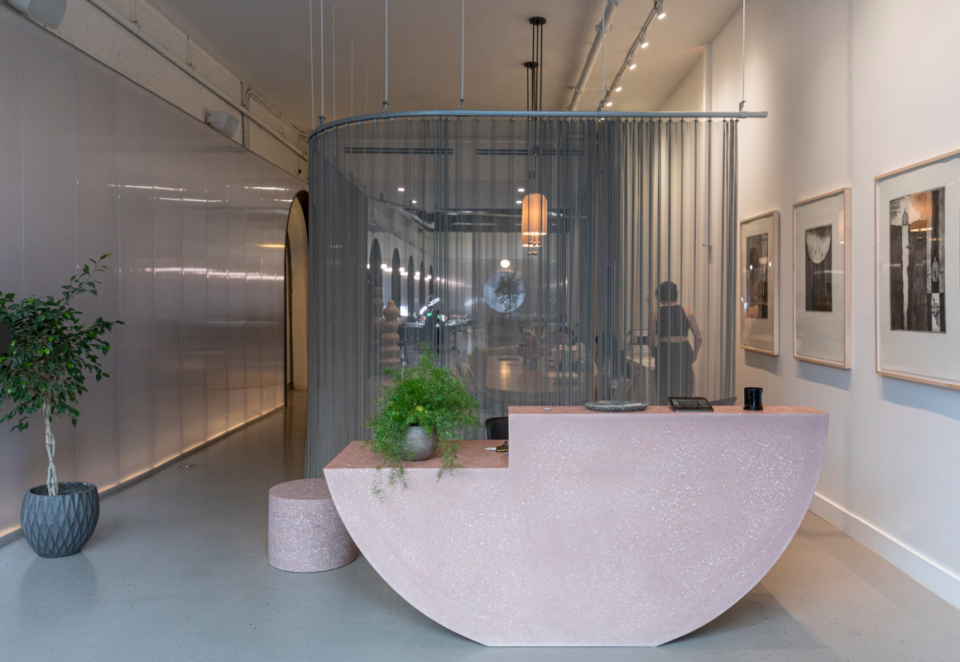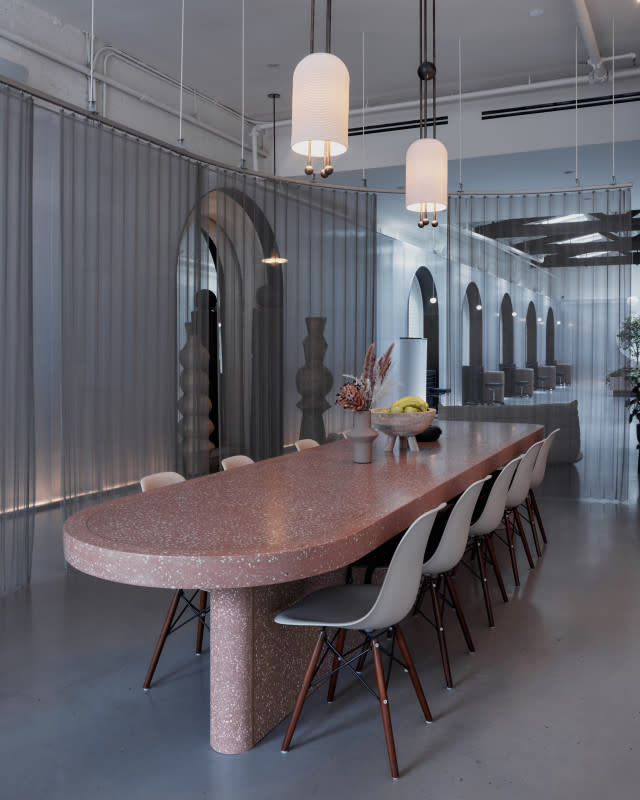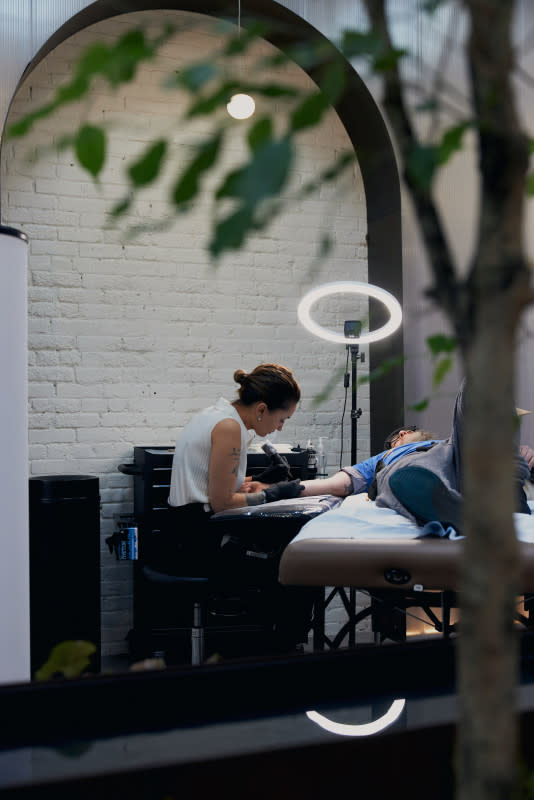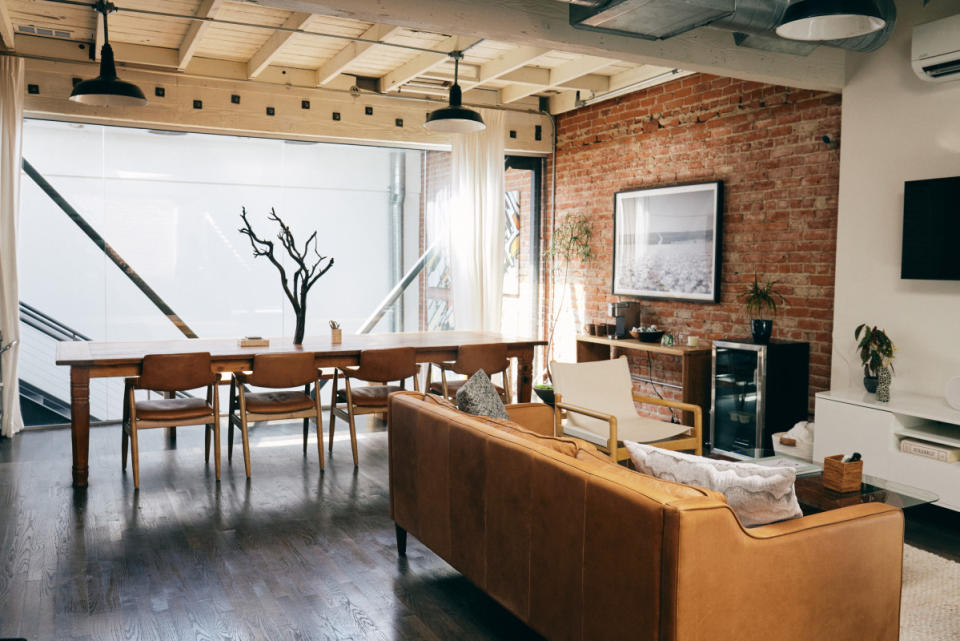When Did Tattoo Studios Get So Chic?
If you were to take a peek inside Atelier Eva's location on Grand St. in Brooklyn, NY, you wouldn't assume it's a tattoo studio. With its custom terrazzo decor, indoor plants and Togo sofa, chances are you'd suspect it was a day spa or an independent boutique.
A signature gardenia scent wafts throughout the space as you make your way towards the artists' stations, each one accented with its own archway — a nod to founder Eva Karabudak's own tattoo work.
Atelier Eva is part of the next wave of tattoo studios boasting an entirely new look, one that's much more aesthetically minded than its predecessors. Gone are the framed tattoo posters, sterile panel ceiling lights and neon-studded storefronts: Now, it's all about creating the most inviting and, of course, content-worthy experience for new and returning clients. And as tattoos continue to become normalized among adults, the spaces to get them are taking design notes from retail, fashion and other service-oriented industries.
View the original article to see embedded media.
A number of tattoo studios across major cities like Los Angeles and New York are using these spaces as an opportunity to stand out and create a more aesthetically branded experience around getting inked. In Brooklyn, Haven Tattoo Studio boasts a pink and green color scheme with plenty of amenities catering to women and the queer community, while Vestige is accented with social-media-friendly details, like squiggly mirrors, boucle furniture and painted murals on the walls. Puppy in L.A. resembles a cool apartment loft, and Supersweet Tattoo not only offers a hyper-feminine space, but coffee and pastries, too.
"While the core of a successful studio will always revolve around having exceptionally talented artists who are deeply committed to their craft, the environment in which they create has now taken on more significance," Karabudak tells Fashionista.
Alongside her business partner and husband Peter Jenkins, the duo have opened not one, but two Atelier Eva studio locations in Brooklyn, catering to a growing clientele that includes celebrities like Sam Smith, SZA and Joe Jonas. "We believe it's crucial to be in an environment that fosters creativity while simultaneously creating a sense of comfort," Jenkins says.

Photo: Courtesy of Atelier Eva
A calm and comforting place was the directive for Alp Bozkurt, the designer tasked with transforming a historic building's 3,000 square feet of wooden beams and skylights into what Atelier Eva's Grand St. location is today.
"The tattoo industry is very male-dominated. Having worked in previous shops that were traditionally grungy — even the higher-end places — they all had a certain old-school tattoo parlor feel to them, and Eva wanted a clear break from that," notes Bozkurt. "The best way to do that is to get a guy who doesn't know what a tattoo studio is supposed to be like."
He instead turned to architect greats like Rem Koolhaas and Richard Gluckman as inspiration for Atelier Eva. The polycarbonate paneling along the space, for example, is an homage to Koolhaas and Gluckman's work behind the Soho flagships of Prada and Helmut Lang, respectively.
"Some of [my] initial conversations [with Eva and Peter] were around whether we should be thinking of this as a fashion brand more than a tattoo brand because that's really what it is," recalls Bozkurt. "Tattoos are accessories now. They say as much about you as your shoes or outfit."

Photos: Courtesy of Atelier Eva

While tattoos have been around for thousands of years, their infiltration into mainstream pop culture has only spanned a handful of decades. In fact, tattoos were still considered illegal in most states throughout the U.S. during the '60s and '70s. New York City didn't lift a ban on tattooing until 1997; Oklahoma was the last state to legalize it in 2006.
Across social media, any stigma around the practice appears to be long gone — a new tattoo is as post-worthy as a 'fit pic. As celebrities and fashion people promote their fresh ink on Instagram, tattoo culture has become more widely embraced, with the artists themselves garnering their own fanbases online; brand deals and big-name collaborations have followed. So it's no surprise that the industry is going through a bit of a revamp. Fine-line and hand-poke tattoos have increasingly replaced Sailor Jerry styles (though the classic aesthetic is still a popular choice), and these days, you could probably get away with a neck tattoo.
Growing demand for tattoos has also given rise to a new generation of self-taught artists. Los Angeles-based Max Lilien pursued tattooing as a hobby in college after purchasing a DIY kit; eventually, his side hustle turned into a full-time gig when he was laid off from his tech sales job in 2020. Over the past three years, he's built a steady roster of clients who would visit his home for a fine-line, hand-poke tattoo. In August 2023, he opened his own private studio, called The Sunroom, in Santa Monica.

Photo: Tanner James Chergosky/Courtesy of The Sunroom
"I was always a little embarrassed of tattooing out of a home studio, but I always got great feedback from clients saying that they actually enjoyed how the experience was less stressful and a little less intimidating," recalls Lilien.
He knew he wanted to capture that same feeling with The Sunroom, so he hired his friend and interior designer Daniella Fields to take on the job. By sourcing the majority of furniture secondhand, she was able to create a modern and cozy space with a bright and clean aesthetic. Five skylights bring in a ton of natural light, while the common area for visitors is studded with ceramic pieces and plants (like an Australian bottle tree — "the most money I've ever spent on a plant," says Lilien), as well as a massive conference table for artists to collaborate with their clients on a design.
"I'd like to think the success of the studio so far has been from the artists and all of the great guest artists we've had since we opened up," says Lilien. "But I think those artists have wanted to guest here because this space is cool. It's a way to cross-promote the studio and their own work. And I think a lot of those artists also want to work here because they know they're going to be in a mellow environment where it's going to be a little more intimate between them and their clients."
Of course, a tattoo studio will always pride itself on having talented artists first. But the benefits behind a desirable location come in at a very close second.
"Space is essential to building strong brands. Physical space embodies your brand and provides a multisensory experience," says Jesse McGowan, the designer behind Keith "Bang Bang" McCurd's Bang Bang Tattoo, one of the most sought-after studios in New York City. (Rihanna, Miley Cyrus, Selena Gomez, Justin Bieber, Cara Delevingne and many more are fans.) "Bang is a huge Disney fanatic, and you can see the impact a compelling physical experience can have in places like theme parks." The two-level Soho space boasts marble fixtures, a black-and-white color palette, an entry tunnel showcasing video art and — wait for it — a koi pond.
"We all agreed that for Atelier Eva's business to be successful, the artists will want to come there to work," says Bozkurt. "The space is now very much a part of their identity. They market it as much as they market their artists. I think that speaks volumes in terms of the real value of design. I feel like I'm constantly trying to prove my value to people, and stuff like this kind of proves it. The end result is it lifts everybody who works there and visits, and it's better for business."
Never miss the latest fashion industry news. Sign up for the Fashionista daily newsletter.

